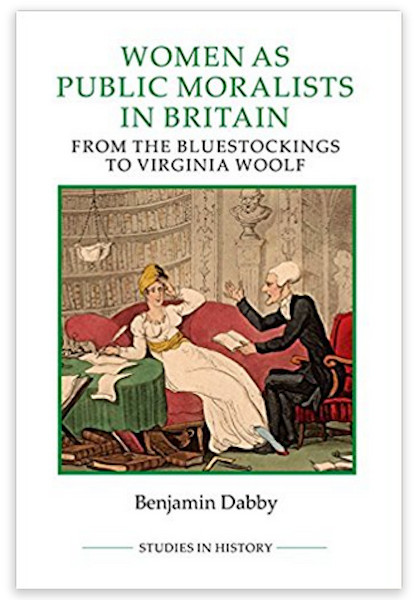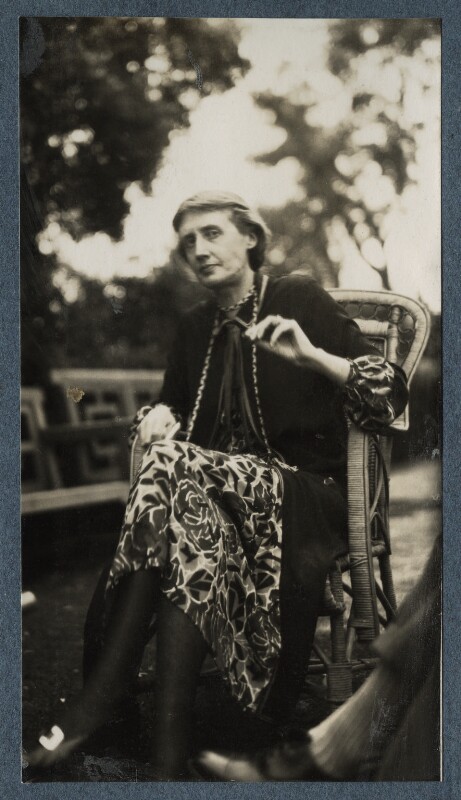This review first appeared in the online inter-disciplinary journal Cercles, where the original can be seen here. The author has reformatted and illustrated it for the Victorian Web, adding links and captions, with the kind permission of the journal. Please click on the images to enlarge them, and for more information about the painting by Frith. Two of the portraits, as specified, come with thanks from the National Portrait Gallery, London; the other comes from the book listed in the bibliography.

Benjamin Dabby's chosen field is a wide and challenging one. He traces the tradition of female moralists from Anna Jameson (1794-1860) to Virginia Woolf (1882-1941), demonstrating their roles as cultural critics and their impact on the women's movement more generally. Although his primary concern is with interventions over time into larger debates about social as well as moral progress, placing the authors in this context yields rich insights into their individual oeuvres. It also indicates that attitudes towards gender that we think of as peculiarly modern have deeper roots than we might suppose.

Anna Jameson, from a photograph by David Octavius Hill (Jameson, facing p. 334).
Dabby begins by making a valuable point. Starting with Jameson's Memoirs of Celebrated Female Sovereigns (1831), he shows how she and several of her peers overturned the idea of women as passive, suffering victims, redefining them through their strengths and their various abilities. Jameson herself chose to open her Memoirs with a flourish, making a heroine of the Queen Semiramis of Assyria, a topical figure at that time because Voltaire's tragedy about her had spawned a number of operas. Arguing for the queen's historical rather than legendary status, Jameson emphasized her accomplishments as the founder of Babylon, leaving her readers in no doubt as to the power and vision of which a woman is capable.
For her part, Hannah Lawrance (1795-1895) stayed nearer home, pushing her revisionist account of English history, Historical Memoirs (1838), back into the medieval period so that she could feature Queen Maude, later known as Queen Matilda (c.1080-1118), who followed the precedent of her mother, Margaret of Scotland, in promoting education by and for women in convents and abbeys. This was useful: it enabled Lawrance to argue convincingly that England's progress depended on women such as these, even before the reign of Good Queen Bess. Later on, in her articles about literature, Lawrance stressed the roles of women as patrons and as characters in poetry and drama to show how much the literary canon owed to them. Clearly, considerably more remained to be done in respect of women's education, but the emphasis on their proven abilities, when properly encouraged and given scope, is heartening and inspirational.
These writers were not voices crying in the wilderness. Lawrance had become a staff-writer on the Athenaeum in 1830, and later contributed to Dickens's Household Words. By mid-century she and others were making their mark in the world of Victorian periodicals — as Kimberly J. Stern has recently demonstrated in The Social Life of Criticism: Gender, Critical Writing, and the Politics of Belonging (2016). The numbers of such women were increasing: as against fifteen in the 1841 census, 600 women would list themselves as "professionally engaged as authors, editors, and journalists" in 1891 (qtd. in Dabby 79). Here was more up-to-date proof of women's skills, and of the power they now wielded in the larger world. Already in 1869 the prolific Margaret Oliphant (1828-1897) could write optimistically in the Edinburgh Review that education would soon open many more doors to women, although the careers she envisaged for them, such as "benevolent-political work" (qtd. in Dabby 79) and treating women's diseases, were still limited ones.
Dabby's subjects are all women who played a part in the essential process of encouragement, by acting not simply as women of letters, but as agents of social progress through moral instruction. This did not necessarily involve pushing for women's rights. Paradoxically, an emphasis on what women had shown themselves capable of achieving could underplay or even obviate the need for formal redress of inequalities. Thinking of their publications in the periodical press, for instance, Oliphant herself felt that women had "public opinion in [their] hands to a considerable extent already" (qtd. in Dabby 78). With her own body of "prodigious journalism" (178), another of Dabby's subjects, Eliza Lynn Linton (1822-1898), took a positively anti-suffrage stance. Nor was she alone in feeling that women's achievements should not come "at the expense of their femininity" (Dabby 183). The novelist Mary Humphry Ward (1851-1920) is not mentioned here, but her anti-suffrage activities and writings in the early part of the twentieth century are well known.

George Eliot as a young woman.
The fear that women might "lose their ready sympathy if they emulated their male peers without question" (155) was a common one, but favouring this "ready sympathy" over men's perceived egotism might only help to perpetuate distinctions between the sexes. Rather, as George Eliot (1819-1880) soon came to realise, both male and female critics should be disinterested. Eliot's early writings have come in for more attention recently, for example in Rosemary Ashton's 142 Strand: A Radical Address in Victorian London (2006). But placing Mary Ann Evans, as she was then, in this context proves particularly useful. Dabby looks at her articles for both the Coventry Herald and the Strand's Westminster Review, and shows that even from the 1850s she was enunciating the principles that she followed later in her novels, and promoting what Dabby calls "the degendered ideal of cultural criticism" (167). In doing so thus early and from this platform she proved deeply influential. Her admiration for eighteenth-century bluestockings in "Women in France: Madame de Sablé" (1854), for example, inspired not only the ardent feminist Mathilde Blind (1841-1896) but a whole generation of younger women who aspired to stand shoulder to shoulder with men, neither held back by nor judged by their gender, in their efforts to advance the social and cultural life of the nation.
As Oliphant's stance suggests, for some women moralists gender was becoming less of an issue. To Beatrice Hastings (1879-1943), for example, it was already no more than a social contruct to be transcended (192-93), while Rebecca West (1892-1983) felt that the socialist movement could never succeed as long as both men and women were fettered by capitalism. The motives of these two women moralists were different, but without making a pitched battle of it, both helped to undermine the patriarchy in their own ways. And this is another important point that Dabby makes. In his conclusion, he suggests that a history like his has not been written before because critics have, in effect, been looking at the subject in terms of just such a battle — reducing their "historical women to being successes or failures on the march to emancipation" instead of seeing them in the broader "communicational context in which they existed" (229).

Hannah Lawrance praised the composition and detailed realism of Frith's Derby Day, and its moral messages about "gambling and excess" (Dabby 143).
This, then, is not so much a corrective to Stephen Collini's male-oriented Public Moralists: Political Thought and Intellectual Life in Britain, 1830-1930 (1994), as an amplification of it. And indeed, what is most striking here is the accumulation of detail about these women's largely unacknowledged contributions to our thinking. For instance, when writing about the new national gallery in Munich, Jameson recommended that paintings should be displayed in good light and in a well-organised fashion so as to enable visitors to study them in close and full detail, and be truly uplifted by them — a "significant precedent to John Ruskin" in this respect (121). Lawrance too was in the vanguard of artistic taste, looking favourably on the Gothic Revival in architecture, and admiring not only the Pre-Raphaelites and William Frith but also Richard Dadd, Augustus Leopold Egg, and others in their circle (or "Clique"). Lawrance sought out talented women painters too, encouraging them to enter their works for exhibitions alongside men's rather than risk being marginalised.

Virginia Woolf, in a vintage snapshot print by Lady Ottoline Morrell, June 1926. NPG Ax142591 © National Portrait Gallery, London.
Contrary to what all this might suggest, and what readers of the gender-bending Orlando (1928) might expect, Woolf, the subject of Dabby's last chapter, returns to a more gendered view of the past in her non-fiction book Three Guineas (1938). Dabby explains this as "a logical response to the diversification of the periodical market and the simplification of women's criticism to the nebulous categories of 'feminist' and 'antifeminist'" (226). Was it not necessary, after all, for women to capitalise on their "historically formed qualities" (220) in order to make society in general, and the professions in particular, "healthier" contexts for both men's and women's efforts (220-21)? Woolf's book-length essay is analysed in depth, and seen as an expression of her belief that "it was women's position outside of the male traditions of thinking that allowed for a reinvigorated whole" (221). It may seem ironic that the position she took here should be so "redolent of an age now past" (227), but it is also fascinating that after all these years and with the enfranchisement of women accomplished, her views should be so close to those of Lawrance, who had found the roots of modern culture in the enlightened efforts of medieval women.
In his conclusion, Dabby divides his women moralists into those who made use of the belief in women's "intuitive sympathy" to validate their ideas, and those who avoided it and focussed on education and ability instead (229-30). Lawrance falls into the latter camp; but Woolf's interest in both "historically formed qualities" and education indicates that these categories are not as mutually exclusive as he suggests. There is much to think about here, and the debate on the nature and impact of women's roles as public moralists in this period will no doubt continue.
Dabby writes with a commendable lack of jargon and in the text itself his wide-ranging scholarship, while evident enough in the extensive footnotes and bibliography, is unobtrusive. It would be a shame not to mention that his book is also unusually well produced, on very good quality paper with an attractive binding. It includes some colour plates illustrating the artworks under discussion as well as a few figures from Jameson's contributions to periodicals. It is an altogether splendid piece of work.
Related Material
- Victorian periodicals mentioned in the Victorian Web
- Regina's Maids of Honour (etching of female contributors to Fraser's Magazine)
- List of periodicals to which Eliza Lynn Linton contributed
- Review of Kimberly J. Stern's The Social Life of Criticism: Gender, Critical Writing, and the Politics of Belonging
Bibliography
[Book under review] Dabby, Benjamin. Women as Public Moralists in Britain: From the Bluestockings to Virginia Woolf. Woodbridge, Suffolk: The Royal Historical Society / The Boydell Press, 2017. Hardback. xv + 288 pp. ISBN 9 780861 933433. £50.00
[Illustration source] Jameson, Anna. Anna Jameson, Letters and Friendships (1812-1860) ed. Beatrice Erskine. London: T. F. Unwin, 1915. Internet Archive. Contributed by University of California Libraries. Web. 25 September 2017.
Created 26 September 2017